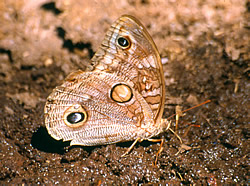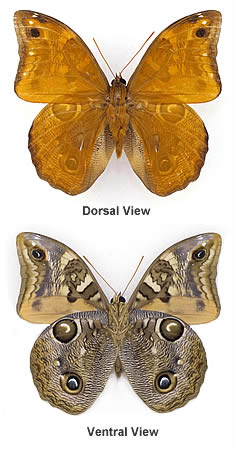Surprisingly, McGuire Center Collections Manager George Austin came across the species while curating butterflies in the Florida Museum, which houses one of the world’s largest collections at more than 6 million specimens.
An online auction for naming rights to a new owl butterfly species discovered at the Florida Museum of Natural History brought a winning bid of $40,800, with proceeds benefiting continued research on Mexican butterflies.

Photo by Doug Danforth
McGuire Center for Lepidoptera and Biodiversity researchers George Austin and Andrew Warren discovered the new butterfly from Mexico’s Sonoran Desert in January 2007 and described it in the November 2007 issue of the Bulletin of the Allyn Museum.
The species’ new common name is the Minerva owl butterfly and its scientific name is Opsiphanes blythekitzmillerae, named in honor of Margery Minerva Blythe Kitzmiller of Ohio on behalf of her five grandchildren. The donor wishes to remain anonymous.
“We are extremely appreciative of this gift which will allow us to continue research with our colleagues in Mexico,” said Warren, a postdoctoral associate at the McGuire Center. “Over the next two years we plan to name several additional new species of Mexican butterflies and conduct fieldwork in poorly known and threatened habitats throughout the country.”
Margery Minerva Blythe was born Nov. 17, 1883, in Malvern, Ohio, and died March 10, 1972. She married Frank Kitzmiller on Sept. 7, 1904, in Cleveland and they lived in Pittsburgh, Pa. They had three sons, all of whom fought in World War II. “She was known as Minerva, or “Bango” to her grandchildren,” said Florida Museum Development Director Beverly Sensbach. “She was an extremely creative person who wrote poetry, played piano and sang, and her grandchildren wanted to honor her by naming this beautiful new butterfly in her memory.”

Photos by Mary E. Warrick
The public auction by iGavel.com ended Nov. 2, 2007, and is believed to be the first time naming rights for a new butterfly species have been auctioned online in North America.
The discovery of this new butterfly is significant because the species is large and colorful, and is the first butterfly from this group to be named in more than 100 years. Most newly discovered species are small and unremarkable because the more noticeable ones were discovered long ago.
“Opsiphanes blythekitzmillerae differs from similar species in its genus by having a unique wing shape and in having slightly translucent, tawny wing scales, allowing the underside pattern to be seen from above,” Warren said. “Because of its coloration, it appears most similar to another owl butterfly, Opsiphanes boisduvallii, but differs from that species in many structural and superficial characters.”
Owl butterflies are some of the most familiar and best-known butterflies in the world due to their large size and striking wing eyespots. The new species has a wingspan of about 4 inches and a beautiful orange color.
Surprisingly, McGuire Center collections manager Austin came across the species while curating butterflies at the McGuire Center, which holds one of the world’s largest collections of Lepidoptera at more than 6 million specimens, and called Warren.
Rather than naming the butterfly themselves, the customary practice when new species are discovered, Austin and Warren decided to auction the naming rights of the new species to raise money to support continued research on Mexican butterflies at the McGuire Center. Researchers at the Alfonso L. Herrera Zoology Museum at the National Autonomous University of Mexico are partners in the process.
John Calhoun, a research associate at the Florida State Collection of Arthropods, said some have worried that such auctions could have enormous ramifications if species are allowed to acquire commercial value, leading people to “discover” new species solely for the monetary potential.
“However, the rigorous process required to actually publish and validate new species makes this outcome less likely,” Calhoun said. “It also demonstrates how science can become self-perpetuating; an important discovery can help fund additional important discoveries. Those who participate in this process are making a real and lasting contribution toward continuing the research on these species.”